What’s in this guide?
What’s an air fryer?
In case you’ve been living under a rock, an air fryer is essentially a countertop version of a convection oven, and a healthier alternative to deep frying (although not all things that you deep fry can go in the air fryer). Since their release in 2010, air fryers have taken the world by storm due to their versatility and the fact that they can cook all your favourite foods without much oil at all and in half the time, using rapid air circulation technology. Just like ovens, air fryers have a heating element and a large fan.
How air fryers work
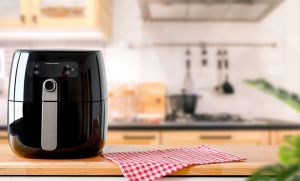 Air fryers work by way of circulating hot air around a vented basked to cook foods evenly and give you crunchy or crispy results in no time. The crisping action is a result of a chemical process called the Maillard reaction, which is a form of non-enzymatic browning that occurs when proteins and sugars in your food are transformed by heat. To put it simply, it’s the reason browned foods taste so good (i.e. toasted marshmallows, chips, cookies, etc.).
Air fryers work by way of circulating hot air around a vented basked to cook foods evenly and give you crunchy or crispy results in no time. The crisping action is a result of a chemical process called the Maillard reaction, which is a form of non-enzymatic browning that occurs when proteins and sugars in your food are transformed by heat. To put it simply, it’s the reason browned foods taste so good (i.e. toasted marshmallows, chips, cookies, etc.).
What’s the difference between an air fryer and deep fryer?
Air fryers use clean circulating hot air to cook foods, while deep fryers use a heating element to super-heat tubs of oil in which foods are cooked at extremely high temperatures. Keep in mind that not all foods that can be deep fried can be air fried and vice versa. This is especially the case with things like wet batter – as the hot air doesn’t get rid of the moisture in the batter like deep frying would. Instead, air fryers are specially designed for crisping up breaded, solid, or crunchy foods. A recent Canstar Blue survey found only 9% of consumers still prefer to use their deep fryer, suggesting more and more people are getting on board the air fryer train!
The major difference between an air fryer and a deep fryer is the amount of oil used. Deep fryers need enough oil to completely submerge the food whereas air fryers use minimal to no oil. This makes air fryers the healthier alternative as there is no excess fat added to your food. Not to mention air frying is more cost-effective since you don’t need to buy so much oil and because air fryers can perform the functions of multiple kitchen appliances at once.
Read more: What’s the difference between air fryers and ovens?
Air fryer pros & cons
| Pros | Cons |
| Crispy food with limited oil
Different designs suited for different needs Variety of models from budget-friendly to pricey Easy to use & clean
|
Fried foods may not be as crispy when compared with a deep fryer
Can’t handle large quantities – have to batch cook if you’re cooking for a large group Takes up bench space and aesthetic models are usually expensive |
Different types of air fryers
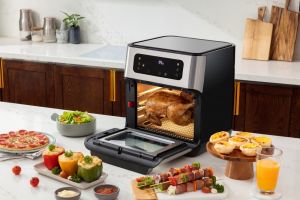 Basically, there are two types of air fryers: cylindrical basket air fryers and air fryer ovens. The most common is the basket-type. Whilst they do have some different features, they essentially work the same way– using convection heating to cook foods evenly and quickly.
Basically, there are two types of air fryers: cylindrical basket air fryers and air fryer ovens. The most common is the basket-type. Whilst they do have some different features, they essentially work the same way– using convection heating to cook foods evenly and quickly.
Basket air fryers have drawers with removable baskets that hold your cook while it cooks, while air fryer ovens look similar to a toaster oven with racks inside and a glass door. Air fryer ovens do take up more bench space but they also have some fancy features that most basket air fryers don’t like the ability to toast, rotisserie, and broil.
However, air fryer ovens do take longer to preheat, and aren’t set up so you can shake mid-way through to ensure even cooking and there are limited choices in terms of aesthetics. Generally, they’re quieter than a basket type, have a larger capacity and you can view food through the door (much like a regular oven) so that you don’t have to interrupt cooking.
Air fryer oven pros & cons
| Pros | Cons |
| Larger capacity
View food through the door Quieter fan Can use a variety of baking dishes that you already own |
Larger – take up more bench space
Generally more expensive You don’t get the option to shake for even cooking Take longer to preheat |
Most air fryers, regardless of which kind you choose, come with pre-set cooking modes for steak, fries, fish, and chicken. Having more settings does not necessarily mean better, it just means more automated settings that save you time, but you can learn more about appropriate temperatures and cooking durations the more you use the appliance!
Basket air fryer pros & cons
| Pros | Cons |
| Quick heat-up time
Take up limited bench space Easy to toss food in the basket and can shake mid-way through to ensure even cooking Lots of different colours and styles to match your kitchen’s aesthetic |
Fan is loud
Can’t see food when cooking unless you pull out the basket (which is okay to do!) Limited capacity – not ideal for larger households |
How to use an air fryer (first timers edition)
- Take everything out of the box: This should include a mesh air fry basket, a baking pan, a wire rack, and a removable crumb tray. Ensure all parts are there and that nothing is missing.
- Wash all removable parts before use: This includes trays and the air frying rack. Check they are dishwasher-safe first and if in doubt, just handwash.
- Read the instructions manual: To get an idea of how each cooking function works and for recipes to follow, especially for the first few times until you’re comfortable going it alone.
Smart tip: Some manufacturers suggest running your air fryer on empty for about 10 minutes (before you use it to cook) to let off any ‘new appliance’ smells and gas from the coating and internal elements. Don’t stress if there’s a chemical smell, it’s normal especially the first time, just open a vent or window. It should just be a one-time thing!
4. Preheat your air fryer: It’s important to preheat your appliance to get it to the optimal temperature before you put your food in so that it can start cooking immediately.
5. Use the built-in timer to ensure precise cooking: Built-in timers can help you nail recipes while you get on with other tasks. They’re also easier to use than relying on variable temperature settings alone since they require some manual intervention from time to time to ensure your food doesn’t get burnt.
6. Cook set recipes: At least until you get to know how your appliance works before you experiment with recipes of your own. Then up your game with traditional dishes like pork belly and potato bake in half the time!
Do you need to preheat your air fryer?
Short answer: yes! To allow your food to start cooking immediately, it’s always best to preheat your air fryer. This only takes a couple of minutes but it can make all the difference! If you’re not preheating your air fryer, you could be setting yourself up for disaster aka undercooked food. Preheating also cuts down on cooking time and will ensure the best final result at the end aka crispy, golden perfection. However, if you’re in a crunch for time and just want to get your food in there, allow for an extra five to 10 minutes of cooking time in the end.
Read more: Top 9 air fryer mistakes to AVOID
Can you still use oil in your air fryer?
There is no rule that you can’t use oil in the air fryer… it just only requires a minimal amount. While not every recipe is going to need oil, a light spray of oil is going to help your food crisp up nicely every time! This is especially the case for chips, spring rolls, or anything breaded. Make sure to put the oil directly onto the food that you’re cooking, as opposed to just straight in the air fryer basket.
What are the best foods to cook in an air fryer?
Air fryers combine all the nifty functions of an oven, microwave, toaster, and deep fryer (without the oil), which means you can cook pretty much everything in them. The exception is foods that have wet batter or are generally soggy. This is because air fryers work best with dry items, such as sausage rolls, potato gems, or breaded mozzarella sticks!
If you’re cooking things that generally contain moisture, such as meat or veggies, give them a quick pat to remove some of the excess moisture to get the best results. This is because an air fryer does not get rid of moisture, if you think about it – it’s just hot air being circulated in a small cavity.
Examples of foods you can cook (this list is not exhaustive) in an air fryer include:
- Frozen foods: Chips, spring rolls, garlic bread, etc.
- Meats: Steaks, chicken, lamb, roasts, etc.
- Seafood: Breaded fish, prawns, calamari rings, etc.
- Veggies: potatoes, carrots, broccoli, etc.
- Desserts: self-saucing chocolate puddings, brownies, cheesecake, etc.
- Breaded foods: mac and cheese croquettes, arancini balls, etc.
Read more: What you can & can’t cook in an air fryer
How to use an air fryer (seasoned cooks edition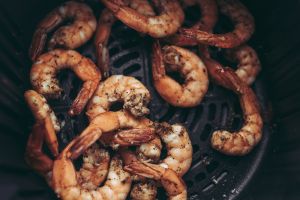
- Experiment with from-scratch recipes: Exercise your inner chef by making something entirely from scratch. Try recipes for chicken parmigiana, fried chicken, etc.
- Up your game with advanced meals: Whether you’re an air fryer enthusiast or just wanting something a bit different for dinner, there are so many options: we’re talking fish tacos, seafood platters, gnocchi, steak, pizza, chicken taquitos and so many more.
- Make breakfast to save time in the morning: If your kitchen is always a hub of activity in the morning, using your air fryer to make some quick (and delicious) breakfasts might make this time a little easier. Air fryer breakfast burritos are a gamechanger. You can make them in advance and freeze them so that you only need to reheat and be out the door! Completely customisable, you can add in whatever your heart desires.
- Try making desserts: Air fryer cheesecake? Count us in! There is a whole world of desserts and other sweet snacks that can be made in an air fryer like crispy apple pie, sticky pudding, s’mores, basically anything that your heart dreams of.
- Bring cold pizza & soggy fries back to life: Is there anything worse than getting back from a Macca’s run to discover that your chips have gone cold or worse, soggy, during the car ride home? Well, you can use your air fryer to revive them! Just preheat as normal, chuck them in, and three and to five minutes later you have crispy chips once more! You can use the same process to bring back cold pizza life.
- Dehydrate foods: Dehydrating foods such as fruit, vegetables, and even meat can be a great way to reduce food waste. The sky is the limit with dehydrating foods, from beef jerky to banana chips, to dried mango or granola. You can alternatively rehydrate foods in liquid to add them to recipes and smoothies. Some air fryers will have a specific setting for dehydrating food or you might be able to dehydrate food in a regular air fryer as long as the temperature can go as long as 50°C. This is because you’re aiming to strip the moisture from the food, not cook it.
How to clean your air fryer
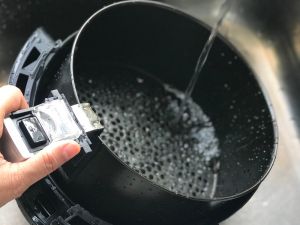 It’s recommended to give your air fryer a wipe-over after each use to avoid food and grease buildup in the cooking chamber and a more thorough clean every week or two, or after a particularly messy cook.
It’s recommended to give your air fryer a wipe-over after each use to avoid food and grease buildup in the cooking chamber and a more thorough clean every week or two, or after a particularly messy cook.
Here’s how to clean your air fryer properly:
- Unplug the air fryer: First thing’s first, make sure that you unplug your air fryer and let it cool down completely before cleaning.
- Dismantle the appliance & clean removable parts: Most air fryers have dishwasher-safe components which make cleaning super easy. Just remove the basket, tray, and pan and wash accordingly. Make sure to check the instructions manual for your specific model before you put anything in the dishwasher, just to be safe. If in doubt, just handwash, always!
- Clean internal parts in soapy water: You can soak and scrub the air fryer basket and pan in warm soapy water until all food debris and grease are gone, or you can alternatively use a mixture of baking soda and vinegar as a natural substitute.
- Clean the main unit: Use a damp cloth to wipe down the main unit to remove any food residue or grease. You should never submerge the main unit of your air in water because of the electrical components.
- Check the heating coil: It’s a good idea to check the heating coil after each cook for any oil or residue. Make sure the appliance is completely cool and unplugged before wiping it over with a damp cloth or dish brush – similar to the heating element on an electric stove.
- Dry & reassemble: The components need to be fully dried before reassembly, this can be done with a towel or just by letting them air dry.
Are air fryers safe?
Yes, air fryers are safe to use if you take the appropriate precautions, like not touching the frying basket with your bare hands while it’s hot and taking care when opening the lid while your food is still cooking. Air fryers are deemed safer than deep fryers which come with an added risk of scalding due to the hot oil. Here’s what you can do to use your air fryer safely:
- Remember that the tray is going to be hot so, if need be, use a heat-resistant mat to keep your benchtops safe and be careful not to touch it.
- Give your air fryer space! Make sure that there is at least 5-10cm space on each side of the unit while it’s cooking.
- Use tongs or an oven mitt to get food out of the air fryer to avoid burning your hands.
- Turn off and unplug your air fryer after every use.
- Don’t get too touchy with your air fryer, the back can get extremely hot.
Air fryer tips & things to keep in mind
- It’s fine to pull out the basket to keep an eye on your food, particularly for the first couple of cooks until you have a better idea of how long certain dishes take to cook in your specific machine. Don’t worry about shutting off the machine, it automatically pauses itself when the basket is out. That’s also how you’ll know whether or not you’ve put it in correctly as it won’t start up otherwise.
- Space out your food in the basket, overfilling the air fryer basket will cause your food to not cook evenly or take twice as long with subpar results.
- Reheat leftovers in your air fryer rather than the microwave for the best results!
Preheat your air fryer: It’s important to preheat your appliance to get it to the optimal temperature before you put your food in so that it can start cooking immediately.



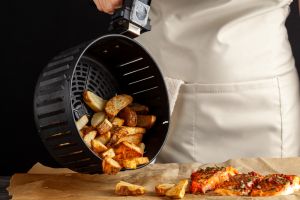
Share this article